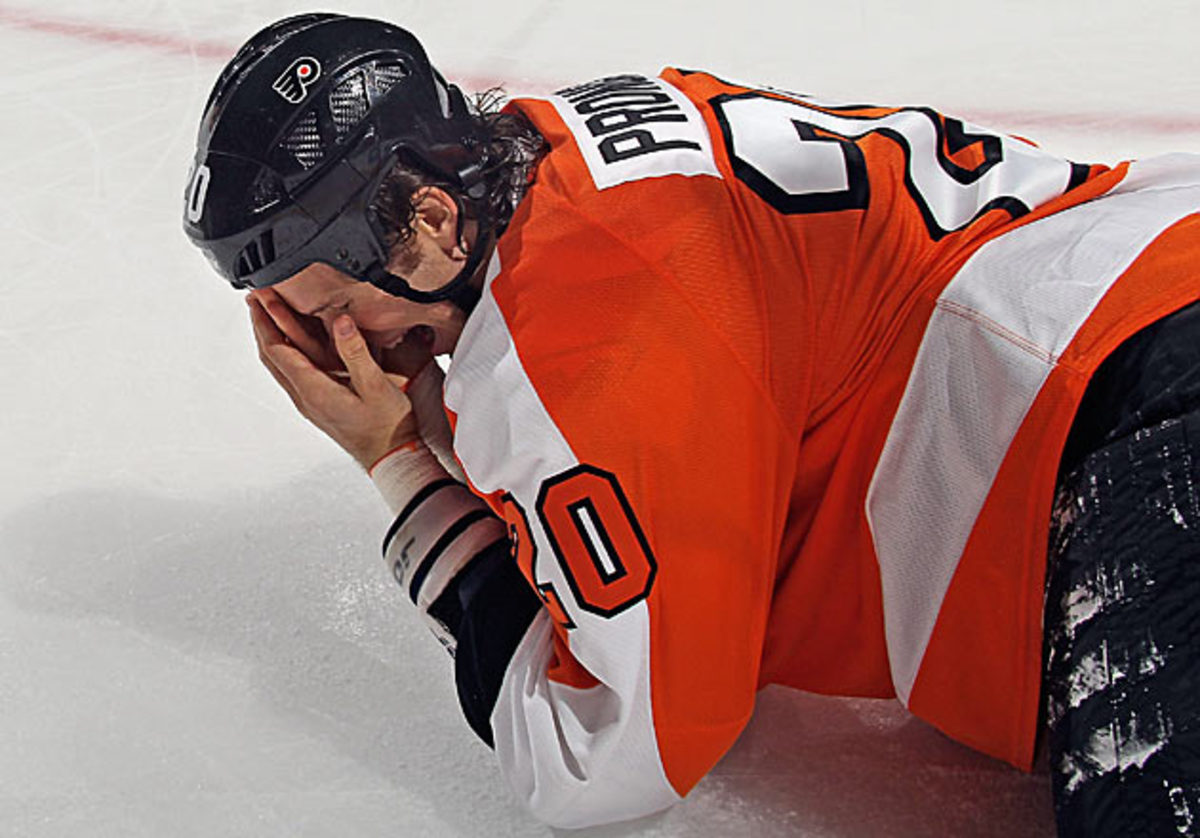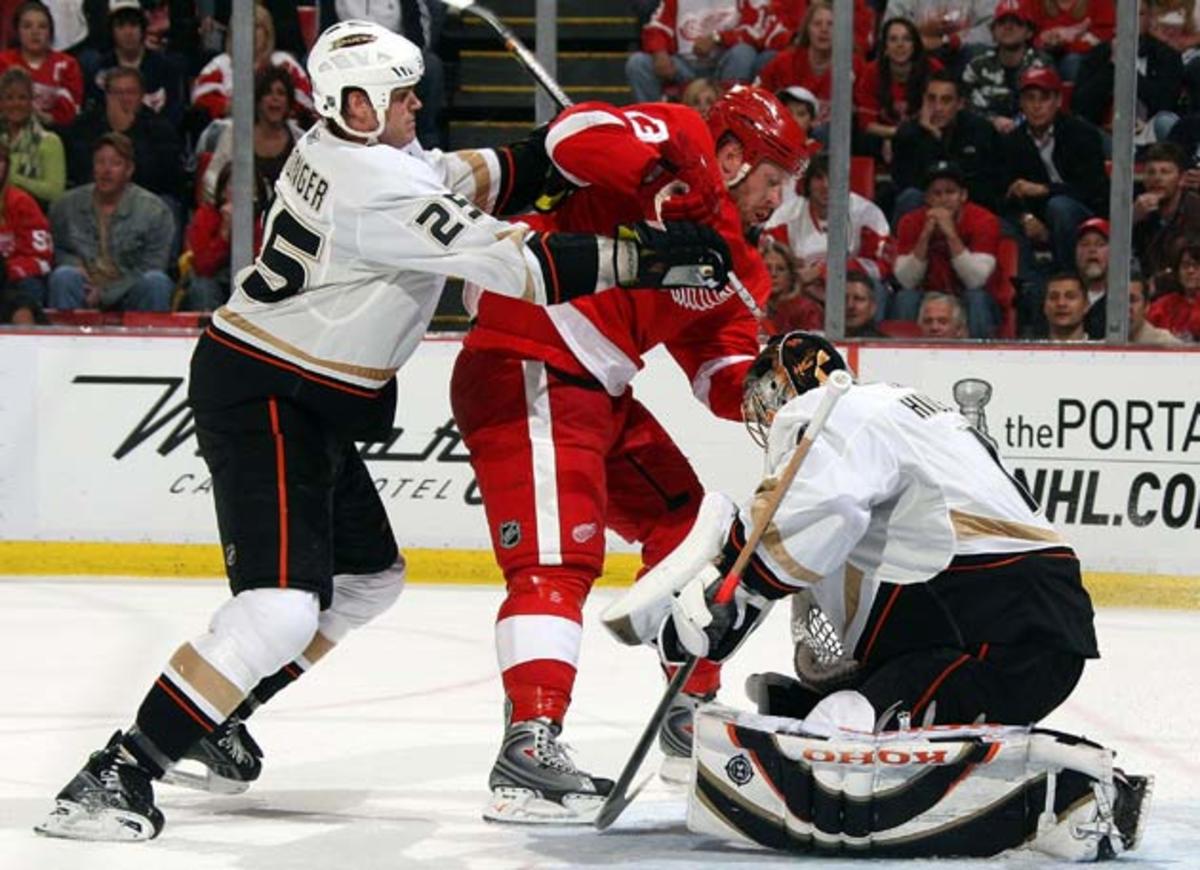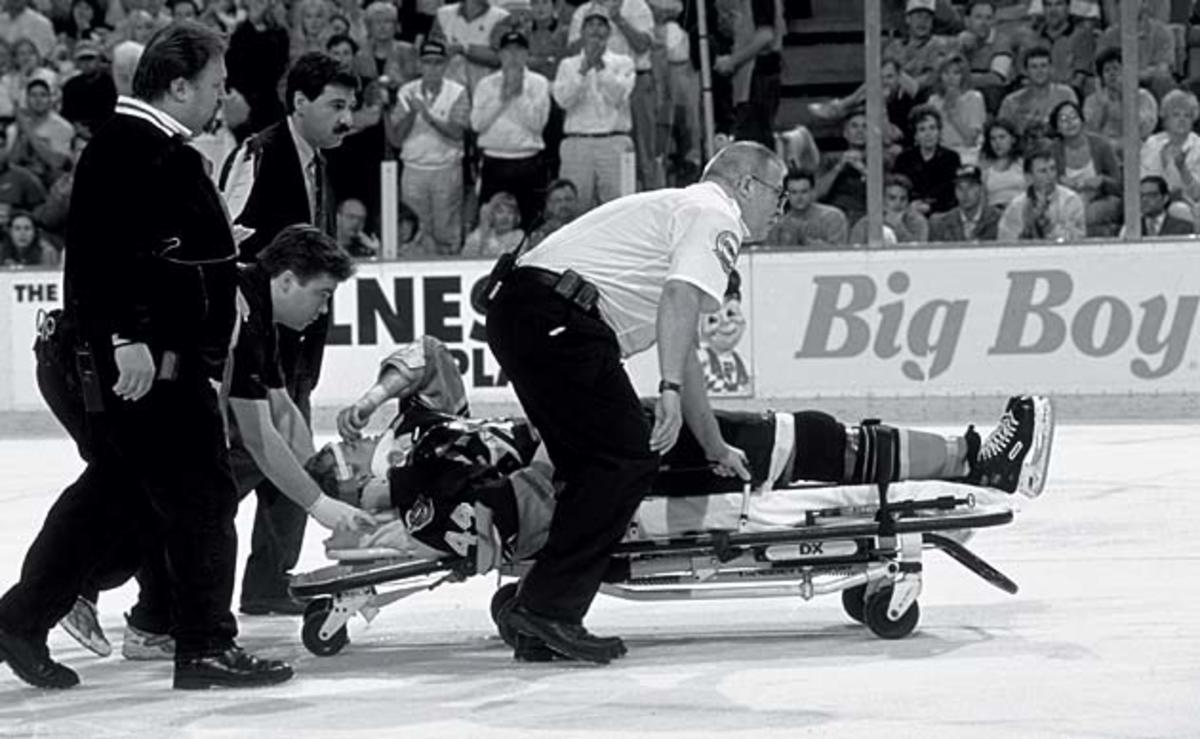SI Vault: Chris Pronger has a headache

The Hockey Hall of Fame’s selection of Chris Pronger as a member of the class of 2015 was not without some controversy as he is still technically active though unable to play. This story, about how eighteen months after an eye injury and post-concussion symptoms derailed his storied career, the defenseman faced a tough life away from the game, originally appeared in the April 22, 2013, issue of Sports Illustrated. Subscribe to SI magazine here. Special Championship Offer: Get a Commemorative Chicago Blackhawks book and framed cover.
Chris Pronger was unprepared for the attack. In a darkened room of his house in suburban St. Louis last year, his son Jack, then nine years old, reached around Chris’s unguarded right flank to embrace him around the waist. Caught unaware, the future Hall of Fame defenseman felt defenseless. “I snapped because I was frightened,” he says. “I tell my kids [Jack, now 10; George, eight; and Lilah, four], ‘You have to stop scaring me. I’m going to whack you or something because I can’t see things coming anymore. It’s not like it used to be.’”
At 38, the Flyers’ former captain is nearly 18 months removed from a severe eye injury and a head injury, suffered in incidents three weeks apart, that drove him into what he calls “a black hole of depression.” Pronger could once command a room with a presence befitting one of the game’s most dominating players. He was uncommonly gifted and menacing, the first defenseman since Bobby Orr to win the Hart Trophy as league MVP. He won two Olympic gold medals with Canada, went to the finals with the Oilers (in 2006) and Philadelphia (in ’10) and won a title in Anaheim (in ’07). Veteran teammates deferred to him, and new ones cowered. “My first day I was intimidated just to meet him,” recalls the Lightning’s Matt Carle, Pronger’s defense partner in Philly from ’09 to ’11. Pronger never hesitated to spar with opponents in the press, and sometimes he took shots at reporters too; he once asked if an opponent who had criticized him was headed to the minors and then checked to see if the writer knew how to spell demotion. He reveled in all forms of combat.
• Pronger through time | Top 20 defenseman of post-Orr era
Today a room commands Pronger. It compels the man once accustomed to being in the spotlight to dim the lights and to be mindful of what he cannot see in his shrinking field of vision. Once fueled by the roar of 18,000 fans, he sometimes winces at the screech of a child. “Headaches, headaches, headaches,” he says. “It takes nothing to get me to sensory overload.”
On Oct. 24, 2011, Maple Leafs center Mikhail Grabovski caught Pronger’s right eye with his stick while following through on a shot. “I still remember the screams,” says Carle. “Prongs never let you know he was hurting, even when he blocked shots, fought, got slashed. That was the scariest thing I’ve seen.” Pronger suffered damage to the eye. He was bedridden for four days but felt he had to return to the ice. “Unless you’re dying, it’s ingrained in our culture to play,” he says. “Pain doesn’t hurt; it’s just pain.”
He missed six games, then came back for five, insisting he felt fine even though, he says, “I was way off. Dizziness, nausea. I hid it. I didn’t say anything. But in the games you’re leaving yourself exposed to hits, making plays you wouldn’t normally make.” In Pronger’s fourth game back Coyotes forward Martin Hanzal drove him into the boards from behind. “Didn’t look bad,” Pronger recalls, “[but] bells started ringing. I just didn’t answer them.” Two nights later he left the arena in Winnipeg feeling woozy and disoriented. He has not played since.

Pronger always delivered more punishment than he received. He would gladly slice into a chiffonade with his stick what his 6' 6", 220-pound frame was unable to mash to a pulp with a bodycheck. “You always knew that when you were in his house, you were going to get poked and knocked around,” says Flyers winger Scott Hartnell, who played against Pronger for eight years until the latter moved to Philadelphia in 2009. “Chris was the best player in the NHL at knowing where you didn’t have padding.” Rival fans rained invective on him. (PRONGER WOULD SPEAR HIS GRANDMOTHER, one sign read.) His wild abandon earned him eight suspensions.
“I stuck some guys with a good one,” says Pronger. “I’m guessing a few guys around the league heard about my injuries and started thinking, Ah, sweet karma.... I didn’t play the game to make friends; I played the game to win. If what happened to me is a by-product of that, I accept it. I’d be a hypocrite to ask for sympathy now.”
Pronger always seemed to have spare eyes above his ears. He possessed Gretzky-like vision on the ice and never seemed to panic with the puck on his stick. “Prongs had an unreal game,” says Carle. “He played the three-on-two more aggressively than I knew you could play it. He took away time and space like it wasn’t there. People were so intimidated by him, they always brought the puck over to my side of the ice. He just taught me to force them into making a play and he'd take care of the rest. His anticipation and his reads were incredible.”
Since his injury, however, Pronger hasn’t been close to the same. He failed his ImPACT Test (used by the NHL to evaluate players after they take a hit to the head) once he returned to Philadelphia from Winnipeg, and spent the next five days gazing into a fog while getting three to four hours of sleep a night. The man who could seemingly see everything—and say anything—was suddenly too sensitive to light and sound to engage with his family. Instead of playing on the trampoline with his kids, he’d toss them a baseball until his arm movements made him nauseous or dizzy. His wife, Lauren, “became the family rock, my referee,” he says, “explaining to the kids why Dad can’t play the same way anymore.”
When friends and teammates reached out to him, he asked for space. He quickly tired of reassuring them when he could give no timetable for when he might feel normal again. He says, “I got sick of the same conversation: Hey, you look good. Really, how am I supposed to look? Isn’t that what you say to old people? And by the way, I feel like crap, so go away.”
[pagebreak]

Last June he moved his family back to St. Louis, where he spent nine years with the Blues (1995 to 2004) and where the lights in his home have dimmers. He still loses his train of thought. “I can be mid-sentence sometimes, and I’ll draw a blank,” he says. “You get used to thinking up ways to buy time so you can figure out what the hell you were just talking about. If I don’t write things down, good luck. I was talking to my mom last night. I take another call, tell her I’ll call right back, 10 minutes. Think I remembered?”
Pronger had been impervious to the dangers of the game: fists, sticks, 100-mile-an-hour slap shots he dived to block. But in the stillness and solitude of recovery he found fear and sank into depression. “It was a dangerous transformation because I didn’t know how I was going to get out of it,” he says. “The buzz was out of my life so fast, and I missed it.... You get isolated, depressed. You don’t want to leave the house. You’re trying to medicate yourself—six beers a night or whatever. You’re not working out. You’re eating chips and chocolate bars, all the staples of a sports reporter’s diet. I was in a pretty dark hole, and my thoughts were swirling. I wouldn’t say I was suicidal, [but] I can see where if you don’t start going in the other direction, [you’re] going to start getting [that way]. At some point I needed to scrap the woe-is-me card.”
Pronger’s rebound began with the new school year last fall, when he decided it was time to “be the husband and father I’m supposed to be ... even if [that meant] firing up the symptoms.” The monotonic hum of an air conditioner, heating vent or refrigerator could be painfully uncomfortable. “I went to one of my kid’s class plays,” he says. “There was a sound in the building. When it’s around and then behind you, it drives you nuts.” He helped coach his boys’ youth hockey teams, and in December he finally received medical clearance (he is a patient of Sidney Crosby’s doctor, Micky Collins, at the University of Pittsburgh Medical Center) to go on the ice with them. “I’m standing at the circle watching them go around, working on their crossovers,” he recalls. “As I’m turning, I’m getting dizzy. I had to tripod it up”—lean on his stick—“and let them go around and just catch them on the other side.”
After his eye injury, Pronger’s right pupil enlarged, causing him to follow objects differently with each eye. When he rides an exercise bike, the bobbing of his head intensifies his headaches. When he reads, his eyes become sore. He has lost 45% of his peripheral vision. He is now vigilant about “pushing the bar”; he lifts light weights and does daily eye exercises that produce both headaches and improvements. He might stare at a series of beads on a horizontal string, adjusting his focus from bead to bead; scan handheld eye charts up and down, then sideways; read words while walking back and forth, because his eyes no longer move out as well as in. “After 50 minutes of all that concentrating,” he says, “I usually lie down. It’s too exhausting.”

Though the NHL doesn’t release concussion numbers, it has tried to stem a rising tide of head injuries in the last three years—some to stars such as Crosby—by making significant rule changes, including penalties for blind-side hits and suspensions for hits targeting the head. “Too many guys these days can empathize with Chris’s struggle,” says Pat LaFontaine, whose concussions cut short his Hall of Fame career in 1998. “Part of yourself is kind of gone. You have to make peace with what’s left.”
Pronger has not officially retired, and both he and Flyers G.M. Paul Holmgren use the phrase never say never when describing his prospects for returning to the ice. Their charade seems absurd, but it serves a purpose, since the team can dodge a yearly $4.9 million hit against its salary cap through the end of his contract in 2016-17 if Pronger is out with an injury. The Flyers will likely keep an office or a scouting job open for him, and he raves about Holmgren’s support.
• NHL careers ended by head injuries
Until Pronger met with Philadelphia beat reporters last month, only his wife had consented to interviews, telling a TV reporter, “It’s been a tough go at home. It’s been a lot of trauma.” But, says Chris, “she’s out of the interview game now. It’s up to me to speak up.”
Chris Pronger, Eric Lindros belong in Hockey Hall of Fame's Class of 2015
Pronger feels that the onus for solving hockey’s concussion problems is not all on the NHL. He wants players to look out for themselves by talking about symptoms and protecting themselves on the ice. “Kids now go a hundred miles an hour, but they have their heads down and expect the referees to protect them,” he says. “If a guy’s coming at you and his head is in front of his body, where are you going to hit him?” Pronger grows animated, jabbing the air with his elbow.
Of course his career shouldn’t end this way. Pronger should finish the way former Devils defenseman Scott Stevens did, belting people into next week right up to his final shift. He deserves a send-off like that of former Bruins great Ray Bourque, who finally hoisted the Cup as a member of the Avalanche in 2001 in a last act of triumph. Yet Pronger insists that you skip the pity. “[Other] people have it a lot worse,” he says. “I’m here, right? I’ll be fine.”
At this he offers proof. “You wouldn’t know it,” he says, “but I got a headache just talking to you.” Then he flashes his mischievous gap-toothed grin; his gamesmanship is now therapy. “You always do that to people, don’t you?”
His familiar cackle caroms off the walls. Chris Pronger just stuck you a good one.
Follow @SI_NHL
